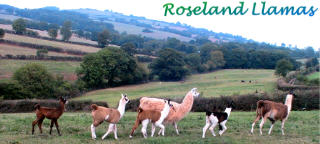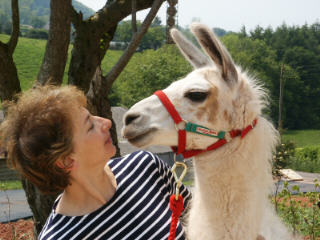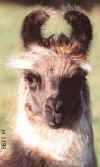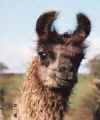|

Llama
Basics & Llama Management
Llamas are gentle and intelligent
~
probably the easiest to maintain, most
versatile, field stock in the world
Llamas...
 | Can be divided loosely into
four types, under two headings - "classic" and "woolly".
 | "Classic" llamas can be
sub-divided into short-woolled (Ccara) and medium-woolled (Curaca),
although the medium-woolled Curaca is often included as Ccara.
Ccara and Curaca
have a short or medium coat on
their bodies with very short, close cropped hair on the
head and down the legs, especially below the knee. They
sometimes lose the longer wool on their necks too when they
mature, leaving their necks with dense but short soft wool.
|
 | "Woolly" llamas can be
divided into heavy-coated llamas (Tapada) which have
a heavy coat on their body
but little wool on the head or below the knee,
and heavy-coated llamas (Lanuda)
that also have lots of fringe wool on the head and whose legs
are woolly right down toward the ankles.
|
 | Terminology such as as Ccara,
Tapada etc, varies depending on the ethnic languages of
South America. Those given above, for example, are Quechuan terms
used in much of Peru. In the Aymara
language, used in Bolivia and South Peru, heavy woolled llamas are
all referred to as "Tampuli".
|
 | The Ccara is the type
of
llama most often seen in the UK, but
"classic" as a description is something
of a misnomer. Before recent imports from South America, most
llamas in Europe (and North America) came from Ccara stock imported from Peru in the
late 19th and early 20th centuries! And
because these were the only llamas known in Europe, they were regarded as
typical - the llama
phenotype, or the "classic llama". In actual fact nearly 70% of
the world's llamas reside in Bolivia and it is estimated that
about 80% of Bolivian llamas are medium or long-woolled. Even in
Peru only 50% are the so-called "classic" short-woolled llama.
|
 | In the UK, Tapadas and
especially Lanudas are still rare but they are a speciality at
Roseland and as the llama
types page show, we have some wonderful examples of the
"woollies"
|
 | Llamas can be described as pony sized although much lighter in build, weighing circa
120-150kg. In South America the average llama is
about 38" at the withers but if you were to take a young cria
(calf) from South America and grow it in the UK it would be likely
to put on an extra 2 to 4 inches due to the more nutritious diet. |
|
Llamas...
 | are not just white as many
people believe, but come in a great variety of colours from white to
black with many shades of brown and grey in between. It is said
that there are some 35 natural shades of llama wool and our hobby
at Roseland is trying to breed them all!
|
 | do not have hooves. Each foot has two
toes with soft pads. The toe nails may need an occasional trim
but usually wear down naturally.
|
 | can be sheared annually or, more usually, every two
years. Importantly, however, they need not be sheared
at all if you do not wish
to harvest the fibre, as
it stops growing at a manageable length.
|
 | have very soft, light and warm fibre which is described as alpaca if its
micron count (thickness) is measured as 28 microns
or under. It can usually be sold at a
good price.
|
 | are gentle, intelligent and highly trainable...
|
 | are very hardy, having flourished for thousands of years
on a sparse diet in a climate where it
can be freezing before sunrise and over 100F by midday.
|
 | do not have to be exercised, nor do they need to be housed at night or in winter
(although a field shelter or stable is desirable and useful).
|
 | calve easily, rarely requiring human intervention.
|
 | eat less than sheep, cattle etc, on a weight ratio basis.
|
 | do not need annual dipping as with sheep.
|
 | are relatively resistant to most diseases found in European livestock.
Although originating
in South America,
they do not suffer from any unusual or
'exotic' problems specific
to llamas or that region.
|
 | They have high resistance to foot-and-mouth disease and
many believe they cannot contract it naturally.
(The UK
foot-and-mouth epidemic of 2001). |
|

Ccara trekking
llama Dooby (on the right!).

A Roseland lanuda female llama with eye lashes and eyebrows to die for!
|
| |
|

Another young Roseland
lanuda female who has curly or
"suri" type fibre.
|
 | Grass is the staple diet of llamas, although they will
nibble on fresh hedge and tree
shoots etc. They are not goat-like, however, in that they will not stay
to strip a tree. |
 | Fresh water should always be available. |
 | Hay can be given ad lib, especially when grass is in
short supply, or conversely, very lush. |
 | A small amount of "concentrates" such as a goat mix or pony mix can also
be given as a treat and to bring the llama/s to hand. Over-feeding
should be avoided. |
 | A llama should not be kept on its own. If not kept in a pair or group, then other
field stock such as sheep make good companions |
 | Standard stock fencing is adequate in most situations,
although higher fencing may be required if you plan to keep more
than one breeding group or, for example, the
field fronts a busy road. |
 | Barbed wire should be avoided. |
Any
Questions? Take a look at our
FAQs pages
|
|